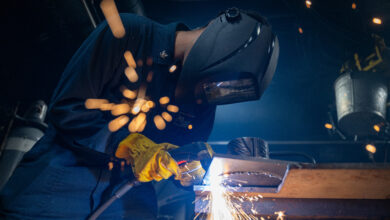After China, US Unveils Rifle-Toting Robot Dogs
The US Army showcased its ground-breaking quadruped unmanned ground vehicle (Q-UGV) armed with an assault rifle during Operation Hard Kill at Fort Drum, New York.
The demonstration was held nearly three months after China showed off its own version of a weapon-carrying robot dog at the onset of its joint military exercise with Cambodia.
A Ghost Robotics Vision 60, the American Q-UGV features an AR-15-type rifle mounted on a small turret on top of its front end.
It also has a relatively large objective lens and electro-optical targeting system that aids in accurately finding targets.
Furthermore, the rifle-toting robot dog appeared to be carrying a laser aiming device on its side and a high-performance camera similar to a GoPro on its rear.
A Ghost Robotics’ Vision 60 quadrupedal unmanned ground vehicle (Q-UGV) armed with an AR-15/M16-type carbine is among the counter-drone capabilities being demonstrated at the U.S. Army’s Fort Drum in New York as part of what has been dubbed Operation Hard Kill. pic.twitter.com/dRxKUqYZMV
— Katherine Champagne (@keccers) August 8, 2024
The armed version of the Vision 60 is reportedly an anti-drone system, with its sensors supposed to detect hostile unmanned aerial vehicles (UAVs) then shoot them down using the rifle.
AI-Enabled
Ghost Robotics’ Vision 60 is a mid-sized, all-weather UGV enabled by artificial intelligence (AI).
It was developed to help the military reach areas otherwise inaccessible to ground vehicles and keep soldiers out of harm’s way.
Weighing only 112 pounds (51 kilograms), the robot dog can travel at speeds reaching 3 meters (10 feet) per second with maximum runtime of 3 hours.
During Operation Hard Kill, the rifle-armed Vision 60 demonstrated its ability to maneuver and aim its AI-enabled weapon autonomously.
Representatives from the army and its industry partners monitored the activity and reviewed the robot’s targeting data.
Chinese Version
A video taken during the China-Cambodia military exercise showed a four-legged robot’s ability to walk, hop, lie down, and move backward like a real canine.
It also demonstrated its ability to lead an infantry unit in penetrating a representative enemy building.
American lawmakers immediately sounded the alarm on the new Chinese innovation, requiring the Pentagon to assess its potential application in future conflicts.
🇨🇳 PLA showcased two robot dogs — including one with a QBZ-95 assault rifle mounted on its back — during the 15-day China-Cambodia Golden Dragon 2024 joint military exercises that began on May 16. pic.twitter.com/b75K26BWzo
— Byron Wan (@Byron_Wan) May 27, 2024












